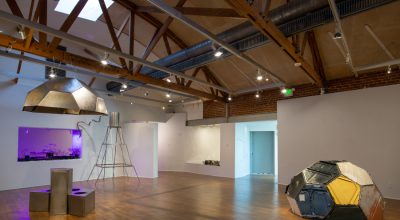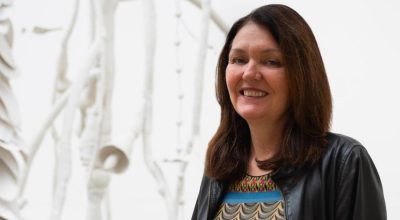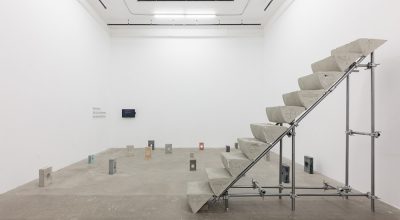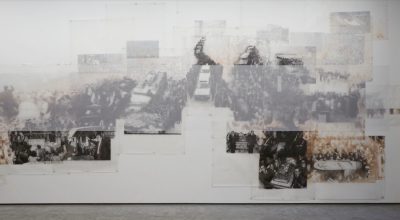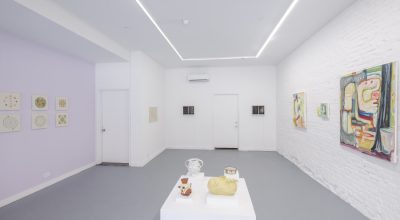English
Mundos Alternos:art And Science Fiction in The Americas
«Mundos Alternos: Art and Science Fiction in the Americas» brings together the work of 30 international artists from across Latin America and the Caribbean, including Mexico, Cuba, Argentina, El Salvador, Brazil, Chile and Puerto Rico, with Latino/a artists from throughout the United States who have tapped into science fiction’s capacity to address cross-cultural dynamics and imagine new realities.
Nari Ward:we The People
The exhibition features over thirty sculptures, paintings, videos, and large-scale installations from throughout Ward’s career, highlighting his status as one of the most important and influential sculptors working today. Since the early 1990s, Ward has produced his works by accumulating staggering amounts of humble materials and repurposing them in consistently surprising ways.
Beatriz Cortez Envisions a World Outside The Confines of Western Civilization
The Craft & Folk Art Museum (CAFAM) presents «Beatriz Cortez: Trinidad / Joy Station», the El Salvador-born, Los Angeles-based artist’s first major solo museum exhibition. With this presentation, Cortez imagines a space of communal living that is dedicated to multicultural coexistence, the survival of indigenous peoples, and experiences of joy.
The Museum of Modern Art Appoints Beverly Adams as The New Estrellita Brodsky Curator of Latin American Art
The Museum of Modern Art (MoMA) announces the appointment of Beverly Adams as the new Estrellita Brodsky Curator of Latin American Art. The endowed curatorial position was created in 2006 in order to help shape the Museum’s collection and exhibition activities. Adams’s responsibilities will include the installation of collection galleries, the development of special exhibitions and catalogues, and participating in the Museum’s acquisitions and research programs for Latin American art. She will join the Museum in the Department of Painting and Sculpture on September 1, 2019.
Rivers Flow Out of my Eyes
In her book «Eruptions of Memory» (2018) the French-Chilean theorist Nelly Richard writes about a ‘completed past’ as opposed to a ‘past being completed’, one which is continually being interpreted in new ways and is thus able to withstand rigid standpoints and apathy in the present. On the basis of this idea «Rivers flow out of my eyes» provides a context for a broad range of reflections on periods of political repression and violence. A merely critical and investigative approach is avoided here. Instead the selected works show an emphatic use of ambiguity, fiction, humor, absurdity and poetic images.
Extra-planetary Commitment
«Extra-Planetary Commitment» is not so much about space flight as it is about the freedom of imagination to critique current establishments and political practices as well as our contemporary daily life. Technology is already redefining the human body and our relationship to nature. Artworks compare the pictorial space of the imaginary with the sculptural conditions of material reality. While imagination can expand into worlds free of gravitation and time, sculptural materiality gives way to a non-human agency.
ISA CARRILLO, CIRCE IRASEMA, LUCÍA VIDALES: TERRA PRETA
«Terra Preta» presents the work of three Mexican artists to consider the sacredness of fertile soil and the relevance of ancient wisdom. Through depictions of Mesoamerican mythology and deity representation, the examination of the rituals and sageness of our precursors, and the construction of an underground imaginary, the exhibition aims to approach the intricate legacy of prosperity within black earth.
Mariana Castillo Deball:finding Oneself Outside
Working in sculpture, printmaking, photography, and installation, Mariana Castillo Deball (b. 1975, Mexico City, Mexico) examines how knowledge and cultural heritage are produced, organized, measured, and authenticated. Her works often take inspiration from Mesoamerican iconography and narratives, considering their early-colonial transformations and their presence in Central America today. The title of her New Museum exhibition, «Finding Oneself Outside», offers a possible description of a sensation that is central to both the study of history and the experience of encountering an unfamiliar culture.
RAÚL DE NIEVES: FINA
«Fina» is the first solo museum exhibition by Raúl de Nieves (b. 1983, Michoacán, Mexico). Through processes of accumulation and a celebration of excess, de Nieves transforms humble materials into spectacular objects and immersive narrative environments. Presented by the Cleveland Museum of Art, «Raúl de Nieves: Fina» features a new site-specific installation of figurative sculptures on a central mirrored structure in the museum Transformer Station’s main gallery. De Nieves mines personal and collective histories, recombining fragments of the past to create timeless fantastical worlds.



